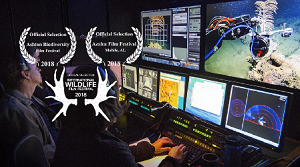 Jewels of the Gulf is a 16-minute documentary highlighting research into Deepwater Horizon’s continued impacts on deep-sea corals.
Jewels of the Gulf is a 16-minute documentary highlighting research into Deepwater Horizon’s continued impacts on deep-sea corals.
Background: On April 20th 2010, approximately 50 miles from the Louisiana coastline, the Deepwater Horizon oil rig experienced a catastrophic failure that resulted in the largest marine oil spill in history. Over the course of 87 days, an estimated 210 million gallons of oil surged into the Gulf of Mexico from a wellhead nearly one mile beneath the surface. Images in the media portrayed the dire consequences to human lives and livelihoods, animals, and shorelines. But there are impacts that the media didn’t cover — the impacts of the spill on the deepwater ecosystems of the Gulf. Ecosystem Impacts of Oil and Gas Inputs to the Gulf (ECOGIG) consortium scientists are documenting the continued impacts of the accident on the unique and beautiful deep sea corals that form the basis of diverse biological communities deep beneath the Gulf’s surface.
The Research: The Jewels of the Gulf research cruise was a 12-day expedition assessing the effects of oil, methane, and chemical dispersants on deep-sea corals. Remotely operated vehicles at over 1000 meters depth captured hundreds of high-resolution still images of corals that the researchers have been monitoring since 2010. The researchers analyzed the images and compared them to those from previous expeditions to document the spill’s impacts and assess the coral’s post-spill recovery and survival. The team, led by Dr. Iliana Baums from Pennsylvania State University, collected both high-resolution images of the corals to document changes over time and live coral samples to study back in the lab. During the expedition, a live ROV camera feed was broadcast so the public could view what the scientists were seeing in real time. To learn more about the Jewels of the Gulf expedition, meet the scientists, and more, visit ECOGIG’s Cruise Blogs here.
Prior to the release of the full-length documentary, ECOGIG released three short videos using footage from the expedition that focused on different aspects of coral research.
Part 1: What is a Deep-Sea Coral?
Thousands of meters beneath the surface of the Gulf of Mexico, ECOGIG scientists study the ecology of deep sea corals living on the seafloor. What is a deep sea coral? How do they nourish themselves in the darkness? What makes them unique?
Part 2: How Do Scientists Study Deep-Sea Corals?
ECOGIG scientists use remotely operated vehicles and high-resolution camera equipment to study deep sea ecosystems in the Gulf of Mexico.
Part 3: Why Study Deep-Sea Corals?
A better understanding of deep sea corals in the Gulf of Mexico will advance our knowledge of deep sea ecosystems as well as guide management decisions in response to future disturbances.
